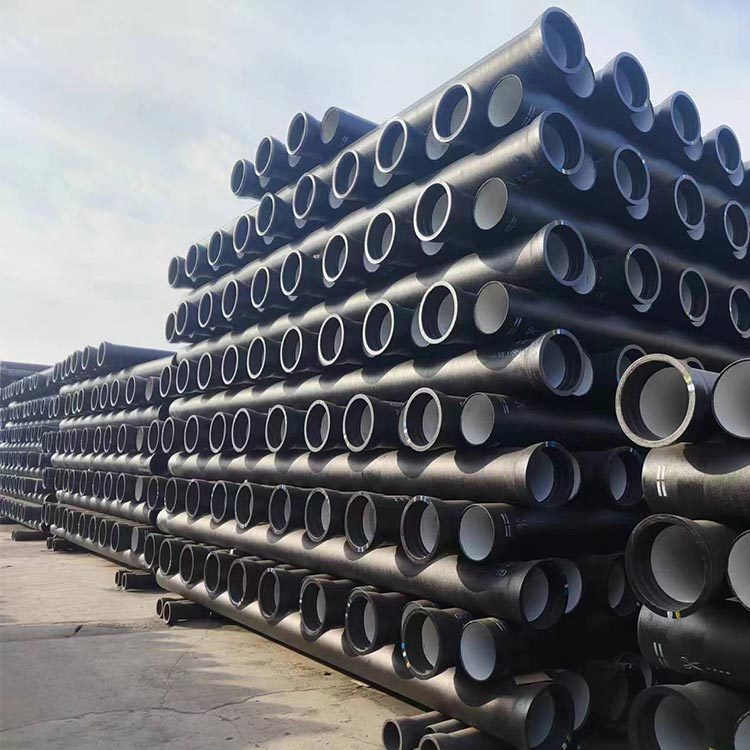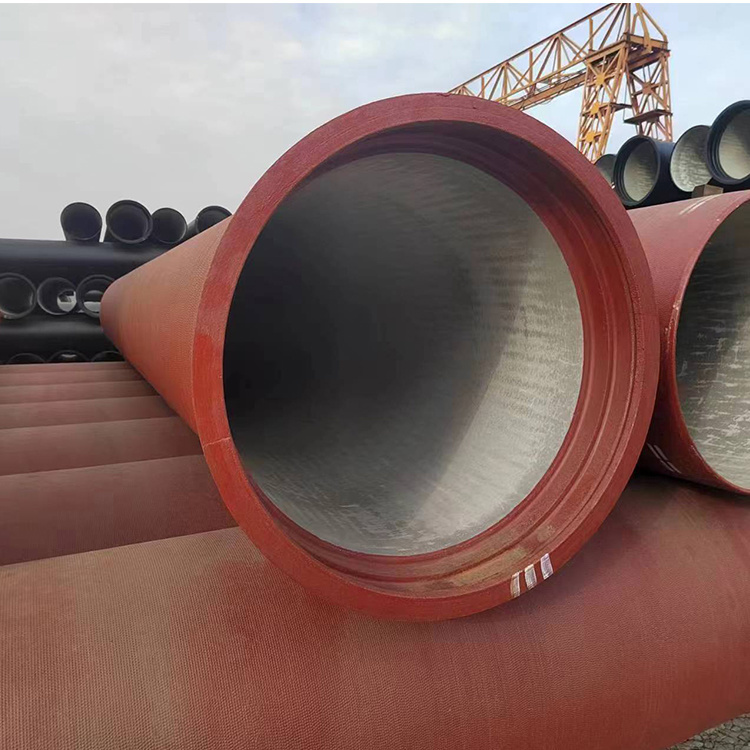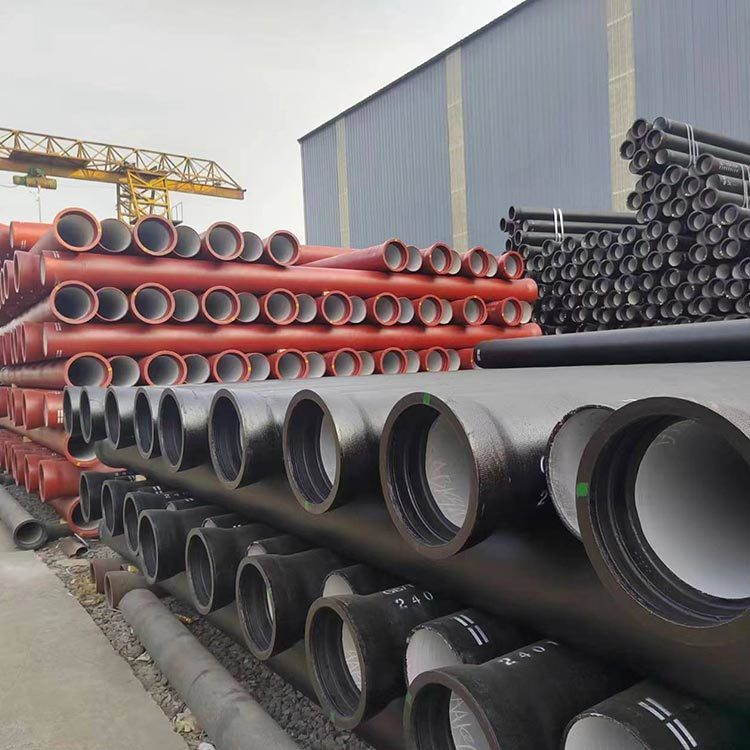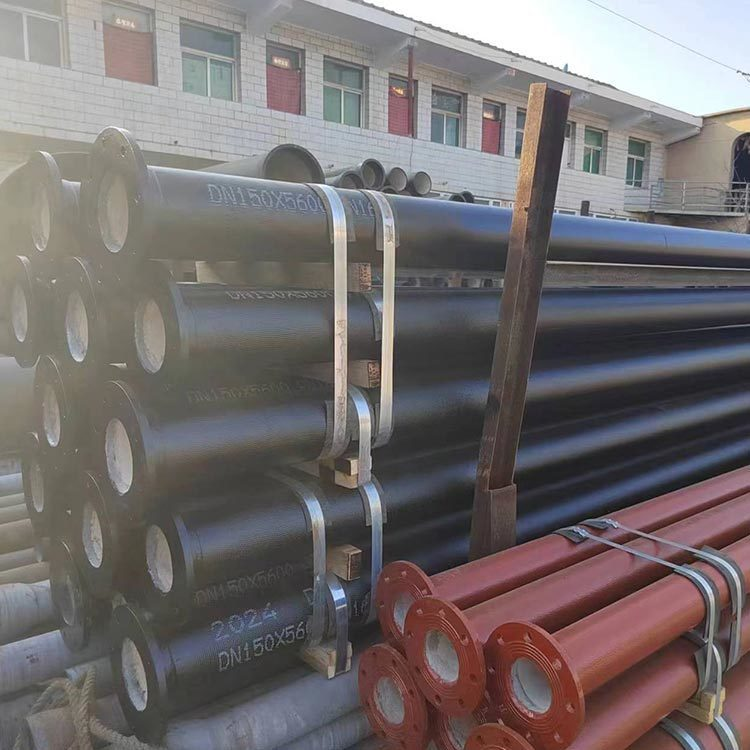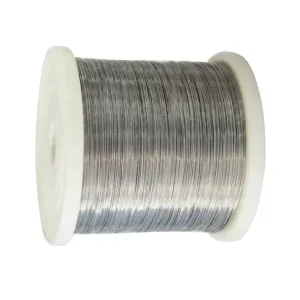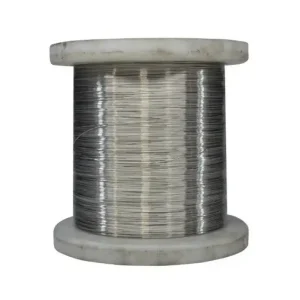We’re often asked: what exactly is ductile iron, and what does “K9” mean? Ductile iron is a kind of cast iron with excellent flexibility and toughness, achieved by adding magnesium (or sometimes cerium) to transform graphite flakes into spheroidal nodules. This structure allows it to deform and absorb impact without cracking—unlike brittle grey cast iron.
The “K” in K9 refers to a wall-thickness class under standards like ISO 2531 and EN 545, and the “9” denotes a specific thickness that supports nominal pressures—higher K means thicker walls and stronger pipes. K9 strikes a smart balance: thick enough for PN 25 service, yet not overbuilt—making it ideal for most water and sewage pipelines.
K9 Ductile Iron Pipe Specifications
| Category | Parameter | Value/Range | Standard/Notes |
|---|---|---|---|
| Basic Specifications | Standard | ISO 2531, EN 545, EN 598, GB/T 13295 | For water/sewage applications |
| Grade | K9 | Wall thickness class | |
| Diameter Range (DN) | DN 80 – DN 2600 mm | DN 1200 max in some sources | |
| Effective Length | 6 m (bulk), 5.5–5.7 m (container) | Custom lengths available | |
| Joint Types | T-type (Push-on), K-type, Self-Restrained | Flexible interfaces | |
| Mechanical Properties | Tensile Strength (≥) | 420 MPa | |
| Yield Strength (≥) | 300 MPa | ||
| Elongation (≥) | 10% | ||
| Hardness (≤) | 230 HB | Brinell scale1 | |
| Pressure Rating | 10–50 Bar | Varies by diameter | |
| Chemical Composition | Carbon (C) | 3.4–3.7% | |
| Silicon (Si) | 2.0–2.4% | ||
| Manganese (Mn) | Not specified | See supplier data | |
| Phosphorus (P) (≤) | 0.08% | ||
| Sulfur (S) (≤) | 0.015% | ||
| Anti-Corrosion Treatment | Internal Lining | Portland cement (ISO 4179) | Thickness: 3–5.5 mm |
| External Zinc Coating (≥) | 130 g/m² (ISO 8179) | ||
| Bitumen Coating (≥) | 70 μm (ISO 8179) | ||
| Alternative Linings | Sulfate-resisting cement, epoxy ceramic | For aggressive soils/water | |
| Dimensional Tolerances | Wall Thickness Formula | e = K(0.5 + 0.001 × DN) | K=9 for K9 grade; e in mm |
| Allowable Deflection at Joints | ±3.5° | T-type joints | |
| Testing & Certification | Hydraulic Test Pressure | Exceeds ISO by 1 MPa | |
| Quality Certifications | ISO 9001, WRAS, BSI, BV | ||
| Inspection | Automated (thickness, coating, pressure) | ||
| Application Parameters | Working Pressure (DN150 example) | 1.6 MPa | |
| Temperature Range | -30°C to 80°C | Varies by lining/coating | |
| Design Life | 50+ years | With proper corrosion protection |
Key Notes:
-
Wall Thickness: Calculated using the formula e = 9 × (0.5 + 0.001 × DN) (e.g., DN 150 → e = 9 × (0.5 + 0.15) = 5.85 mm).
-
Gaskets: NBR, SBR, EPDM, or natural rubber (ISO 4633 compliant).
-
Installation: T-type joints allow quick assembly (±3.5° deflection accommodates ground shifts).
-
Customization: Linings (e.g., polyurethane, epoxy) and coatings adapt to corrosive environments.
Mechanical Properties of K9 Ductile Iron Pipe
| Property | Test Standard | Value (Minimum/Standard) | Notes |
|---|---|---|---|
| Tensile Strength (Rm) | ISO 6892-1 | ≥ 420 MPa | Ultimate strength before fracture |
| Yield Strength (Rp0.2) | ISO 6892-1 | ≥ 300 MPa | Stress at 0.2% permanent deformation |
| Elongation (A) | ISO 6892-1 | ≥ 10% | Over gauge length 5.65√S₀ (S₀: cross-section area) |
| Hardness | ISO 6506-1 | ≤ 230 HB | Brinell Hardness (500 kgf load, 10 mm ball) |
| Modulus of Elasticity | ISO 1083 | 170 GPa | Typical value; varies slightly by composition |
| Impact Toughness | ISO 148-1 | ≥ 14 J (at 23°C) | Charpy V-notch test; ductile-brittle transition temp ≈ -20°C |
| Burst Pressure | ISO 2531 | ≥ PN 50 (5.0 MPa) | Varies by DN size (e.g., DN 100: ~9.5 MPa) |
| Fatigue Strength | ISO 12107 | ±150 MPa (10⁷ cycles) | Rotating bending fatigue limit |
| Poisson's Ratio | ASTM E132 | 0.27–0.30 | Standard for ductile iron |
| Thermal Expansion | ASTM E228 | 11 μm/m·°C | Linear coefficient (20–100°C range) |
Key Notes:
-
Testing Methods:
-
Tensile/Yield/Elongation: Tested on machined specimens from pipe walls (per ISO 6892).
-
Hardness: Measured at mid-wall thickness; max 230 HB ensures machinability.
-
-
Pressure Performance:
-
Burst Pressure exceeds nominal pressure (PN) by 2.5–3× (e.g., PN 16 pipe bursts at ~40–48 bar).
-
Allowable Operating Pressure: PN 10 to PN 50 (1.0–5.0 MPa), depending on DN size.
-
-
Material Resilience:
-
High elongation (≥10%) and impact toughness (>14 J) prevent brittle fracture.
-
Fatigue strength supports cyclic pressure loading (e.g., water hammer).
-
-
Supplementary Data:
-
Compressive Strength: ≈750–1000 MPa (not standardized but critical for trench loading).
-
Density: 7.1–7.2 g/cm³.
-
Example Calculation (DN 500 Pipe):
| Parameter | Formula | Value |
|---|---|---|
| Wall Thickness (e) | e = K(0.5 + 0.001·DN) K=9 |
9.0 mm |
| Burst Pressure (P) | P = 2·Rm·e / (DN - e) | ~7.8 MPa |
Sources: ISO 2531:2020, EN 545:2010, EN 1563:2018 (ductile iron material standard).
Chemical Composition of K9 Ductile Iron Pipe (Weight %)
| Element | Symbol | Standard Range (ISO 1083/EN 1563) | Functional Role | Permissible Deviation |
|---|---|---|---|---|
| Carbon (C) | C | 3.40–3.70% | Forms graphite nodules; enhances castability & vibration damping | ±0.05% |
| Silicon (Si) | Si | 2.00–2.40% | Controls matrix structure (pearlite/ferrite); improves fluidity | ±0.10% |
| Manganese (Mn) | Mn | ≤0.30% | Increases strength; stabilizes pearlite structure | +0.05% |
| Magnesium (Mg) | Mg | 0.03–0.05% | Critical for nodularization (forms spheroidal graphite) | ±0.005% |
| Phosphorus (P) | P | ≤0.08% | Reduces toughness if >0.05%; forms hard phosphides | +0.005% |
| Sulfur (S) | S | ≤0.015% | Consumes Mg; inhibits nodule formation if excessive | +0.002% |
| Copper (Cu) | Cu | ≤0.40% | Optional for enhancing corrosion resistance & strength | By agreement |
| Chromium (Cr) | Cr | ≤0.08% | Hardens matrix; may reduce ductility if >0.05% | +0.01% |
| Tin (Sn) | Sn | ≤0.03% | Stabilizes pearlite; improves hardness | Not specified |
| Aluminum (Al) | Al | ≤0.030% | Prevents gas porosity; deoxidizer during melting | +0.005% |
Critical Trace Elements (Maximum Limits)
| Element | Max Limit | Reason for Restriction |
|---|---|---|
| Lead (Pb) | 0.002% | Causes graphite degeneration |
| Titanium (Ti) | 0.050% | Forms carbides; reduces machinability |
| Antimony (Sb) | 0.002% | Promotes vermicular graphite |
| Bismuth (Bi) | 0.002% | Interferes with nodularization |
| Tellurium (Te) | 0.001% | Creates chill defects |
Key Metallurgical Notes:
-
Carbon Equivalent (CEV)
-
Formula: CEV = %C + (%Si + %P)/3
-
Typical Range: 4.3–4.5 (ensures optimal castability without shrinkage).
-
-
Nodularity Requirement:
-
≥90% spheroidal graphite (per ISO 945-1:2019, Type VI).
-
Nodule count: 100–150 nodules/mm².
-
-
Heat Treatment:
-
Annealing may be applied to achieve ferritic matrix (>80% ferrite) for maximum ductility.
-
-
Material Certification:
-
Ladle analysis must comply with ISO 1083 Grade EN-GJS-500-7 (equivalent to K9 pressure class).
-
Global Standards and Quality Assurance
Adherence to international standards isn't just a compliance formality for MWalloys; it's a testament to our unwavering commitment to quality, safety, and interoperability. We understand that our products are deployed in diverse environments globally, and thus, meeting universal benchmarks is non-negotiable.
Key International Standards Our Pipes Comply With:
- ISO 2531: Ductile iron pipes, fittings, accessories and their joints for water or gas applications – Requirements and test methods: This is the foundational international standard governing ductile iron pipes. Our K9 classification directly references the specifications outlined in ISO 2531, ensuring consistency in dimensions, mechanical properties, and performance.
- EN 545: Ductile iron pipes, fittings, accessories and their joints for water pipelines – Requirements and test methods: This is the European equivalent of ISO 2531, with very similar technical requirements. Our pipes are fully compliant with EN 545, facilitating their use across European markets.
- AWWA C151/A21.51: Ductile-Iron Pipe, Centrifugally Cast, for Water: For the North American market, our pipes meet the stringent requirements of AWWA C151, which covers manufacturing, dimensions, and testing for ductile iron pressure pipe.
- AWWA C150/A21.50: Thickness Design of Ductile-Iron Pipe: This standard provides the methodology for designing the wall thickness of ductile iron pipes, ensuring they can safely withstand internal pressure and external loads. Our K9 pipes are inherently designed to this standard's principles.
- AS/NZS 2280: Ductile iron pipes and fittings: We also ensure compliance with Australian and New Zealand standards, broadening our reach and ensuring suitability for projects in those regions.
We implement rigorous Quality Control (QC) and Quality Assurance (QA) protocols throughout our manufacturing process. From raw material inspection to final product testing, every stage is meticulously monitored. This includes:
- Spectrographic Analysis: Ensuring the precise chemical composition of the ductile iron.
- Tensile Testing: Verifying minimum tensile strength and elongation.
- Hydrostatic Pressure Testing: Each pipe undergoes a hydrostatic test at pressures significantly higher than its nominal working pressure to ensure leak-tightness and structural integrity.
- Impact Testing: Confirming resistance to sudden forces.
- Coating and Lining Adhesion Tests: Ensuring the protective layers are robust and well-bonded.
Diverse Application Scenarios
The versatility of MWalloys K9 ductile iron pipes is truly remarkable. We've seen our pipes deployed in an extensive array of projects, each benefiting from their inherent strength, longevity, and adaptability. Our customers often express their satisfaction with the performance of our pipes across various sectors.
Key Application Areas:
- Potable Water Supply Systems: This is arguably the most common application. K9 pipes are ideal for main transmission lines, distribution networks, and service connections, ensuring the safe and reliable delivery of clean drinking water to communities. Their non-permeable nature prevents external contaminants from seeping into the water supply.
- Wastewater and Sewage Collection Systems: From gravity flow to force mains, ductile iron pipes are highly effective for conveying sewage and wastewater. Their robust construction resists corrosive elements often found in sewage, and their strength handles the external loads from burial.
- Irrigation Systems: In agricultural settings, K9 pipes are used for large-scale irrigation projects, efficiently transporting water over long distances and to various elevations, helping to sustain crop yields.
- Fire Protection Systems: Due to their high-pressure rating and resistance to external damage, ductile iron pipes are a preferred choice for fire hydrant supply lines and fire suppression systems, ensuring water availability in emergencies.
- Industrial Applications: Various industries, including mining, power generation, and manufacturing, utilize ductile iron pipes for conveying process water, slurries, and other industrial fluids, valuing their durability and resistance to harsh operating conditions.
- Seawater Intakes and Outfalls: In coastal areas, ductile iron pipes with specialized coatings are used for seawater intake and outfall lines, demonstrating their resistance to saline environments.
- Trenchless Installations (Horizontal Directional Drilling, Pipe Bursting): The inherent strength and joint integrity of ductile iron pipes make them suitable for trenchless technologies, minimizing disruption to surface infrastructure and reducing excavation costs.
Comparison with PVC & Steel
| Feature | K9 Ductile Iron | PVC Pipe | Carbon Steel Pipe |
|---|---|---|---|
| Nominal pressure | PN 10–25 | PN 6–16 | PN 10–40 |
| Internal roughness | K=0.03 mm |
|
~0.05 mm |
| External load resistance | Very high | Moderate, needs bedding | High, but corrosion risk |
| Corrosion | Z + bitumen protects | UV & chemical resistant | Needs coatings/polywrap |
| Lifespan | 100–110 years | 50–70 years | 50–75 years (coat dependent) |
| Joint leakage | <0.1 % of flow | <0.5 % | Medium |
| Installation tools | Hand tools | Heat + solvent joints | Welding / heavy structure |
Installation Technical Specifications
Proper installation is paramount to achieving the full design life and optimal performance of MWalloys K9 ductile iron pipes. While ductile iron is robust, adherence to best practices ensures system integrity and minimizes future maintenance. Our technical support team is always ready to assist with specific project requirements.
Key Installation Considerations:
- Trenching and Bedding:
- Trench Width: Trenches should be wide enough to allow for proper working space, joint assembly, and compaction of backfill, typically 0.6m to 1.0m wider than the pipe's outside diameter.
- Foundation: The trench bottom should be firm and uniform. For unstable soils, a stable foundation of compacted granular material (e.g., crushed stone) is required. Any rocks or obstructions must be removed to prevent point loading on the pipe barrel.
- Bedding: A bedding layer of granular material (typically 100-150mm thick) should be placed and compacted to provide uniform support along the pipe's length. This helps distribute external loads evenly.
- Pipe Laying and Jointing:
- Handling: Pipes should be handled with slings or approved lifting equipment to prevent damage to coatings and linings. Do not drop pipes or allow them to strike hard surfaces.
- Preparation: Clean the spigot end and the bell socket before jointing. Lubricate the spigot end and the rubber gasket with an approved, non-petroleum-based lubricant.
- Joint Assembly (Push-on Joints - Tyton/ZMU): Align the spigot with the bell. Insert the spigot squarely into the bell until it contacts the gasket. Push the spigot fully home using a lever, jack, or excavator bucket, ensuring the joint is properly seated.
- Joint Assembly (Mechanical Joints): Position the gland, gasket, and follower flange. Insert the spigot into the bell. Tighten the bolts in an alternating, diametrically opposite pattern to ensure even compression of the gasket and a watertight seal. Torque wrenches are often recommended to achieve specified bolt torques.
- Deflection: Push-on joints allow for significant angular deflection (typically 3-5 degrees depending on DN), which is useful for curves or minor alignment adjustments. Do not exceed recommended deflection limits.
- Backfilling and Compaction:
- Initial Backfill: Place selected granular material (e.g., sand or fine gravel) in layers (150-300mm) around the pipe and up to 300mm above the pipe crown. Each layer should be compacted to a specified density (e.g., 85-90% Modified Proctor). This provides support and protects the pipe.
- Final Backfill: The remaining backfill material can be native excavated soil, provided it is free of large rocks or debris. This should also be placed in layers and compacted to prevent settlement.
- Compaction Equipment: Use appropriate compaction equipment. Vibratory plates or tampers are suitable for initial backfill; rollers can be used for final backfill where feasible. Avoid heavy compaction equipment directly over the pipe crown until sufficient cover has been achieved.
- Testing:
- Hydrostatic Testing: After installation, the pipeline section must be hydrostatically tested at a pressure greater than the working pressure (PMA) for a specified duration (e.g., 2 hours). This verifies joint integrity and pipe soundness. Water for testing should be potable and chlorinated if for drinking water systems.
- Leakage Test: Alongside hydrostatic testing, a leakage test is performed to measure the amount of water lost from the system. Acceptable leakage rates are defined by standards like AWWA C600.
- Corrosion Protection (External):
- MWalloys K9 ductile iron pipes come standard with a zinc coating and bituminous finish for external corrosion protection. For aggressive soil conditions (e.g., highly corrosive soils with resistivity < 1500 ohm-cm), supplemental protection like polyethylene encasement (loose wrap) or cathodic protection might be required. This is a crucial step to ensure the longevity of the pipe in challenging environments. ISO 8179 provides guidelines for external zinc coatings, a testament to its effectiveness.
- Cutting and Tapping:
- Ductile iron pipes can be cut in the field using appropriate cutting tools (e.g., abrasive saws, pipe cutters). Ensure the cut end is chamfered and clean before jointing.
- Tapping for service connections can be performed under pressure using standard tapping saddles and equipment.
By adhering to these technical specifications, project engineers and contractors can maximize the performance, reliability, and lifespan of MWalloys K9 ductile iron pipe systems, ensuring a successful and sustainable infrastructure.
Frequently Asked Questions (FAQs)
- What is the typical lifespan of MWalloys K9 ductile iron pipe?
- MWalloys K9 ductile iron pipes are renowned for their exceptional longevity. With proper installation and appropriate corrosion protection, they have a proven service life exceeding 100 years. Many ductile iron pipelines installed over a century ago are still in active service today, which is a testament to their enduring quality.
- How does K9 ductile iron pipe resist corrosion?
- Our K9 ductile iron pipes come with inherent and applied corrosion protection. Externally, they are typically coated with a layer of metallic zinc, followed by a bituminous or synthetic resin finish. Internally, a cement mortar lining provides excellent protection against corrosive liquids, particularly water. For highly aggressive soil conditions, supplemental polyethylene encasement is recommended, providing an additional barrier against corrosive agents in the soil.
- Can MWalloys K9 ductile iron pipes be used for trenchless applications?
- Absolutely. The high tensile strength, ductility, and robust joint systems of MWalloys K9 ductile iron pipes make them highly suitable for various trenchless technologies, including horizontal directional drilling (HDD), pipe bursting, and pipe jacking. Their ability to withstand pulling forces and external loads during installation is a significant advantage in these applications.
- Are MWalloys K9 ductile iron pipes environmentally friendly?
- Yes, we consider ductile iron an environmentally responsible choice. Ductile iron is primarily made from recycled ferrous scrap, making it a sustainable material. Furthermore, ductile iron pipes are fully recyclable at the end of their exceptionally long service life, minimizing waste. Unlike some plastic pipes, ductile iron does not leach microplastics or other chemicals into the conveyed fluid.
- What types of joint systems are available for MWalloys K9 ductile iron pipes?
- MWalloys offers a range of reliable joint systems to suit different project needs. The most common are push-on joints (e.g., Tyton type), which feature a rubber gasket for a leak-tight and flexible seal, allowing for angular deflection. We also provide mechanical joints (flanged joints, restrained joints) for specific applications requiring rigid connections or additional restraint against thrust forces.
- Is special training required for installing K9 ductile iron pipes?
- While ductile iron pipe installation is straightforward, it benefits from skilled labor familiar with heavy pipe handling and joint assembly techniques. Specific training on proper trenching, bedding, joint lubrication, assembly procedures, and hydrostatic testing is always recommended to ensure optimal performance and safety. Our team can provide guidance on best practices for installation.

